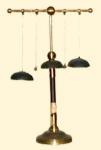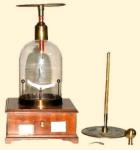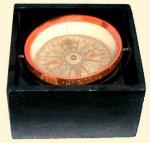 Menu
Menu
|
Function To show the ignition of a gas mixture thanks to an electric discharge. |

| ||
|
|||
|
Description It is formed by a little metallic container in which we introduce a gas mixture, airtightly closed by a cork. There is also a little spark gap with two brass spheres that communicating with the inside. | |||
|
Function To show electric attractions and repulsions. |

| ||
|
|||
|
Description A bell is anchored to a vertical pole. Two other bells hang on the sides of the first one. Between them hang two metallic little balls. By earth-connecting the central bell and the lateral bells to an electrostatic machine, the two little balls are charged by induction and attracted by the lateral bells. Then they are pushed back towards the central bell because their charge becomes of the same sign as the bells. When in contact with the central bell they discharge and the cycle starts over again. | |||
|
Function Instrument for the measure of the electric charge. |

| ||
|
|||
|
Description A glass bulb is placed over a wooden case. A metallic pole with two gold leaves at one end arrives inside the bulb through the neck. On the other end we can have a sphere, a pit or the plate of a capacitor. Inside the bulb we have an index that indicates the divergence of the leaves. By placing a charged body in contact with the sphere, the leaves will charge with the same sign and diverge. The leaves diverge even if the sphere is charged by induction. In fact they both charge with the opposite sign of the sphere. | |||
|
Function Orientation. |

| ||
|
|||
|
Description It is held in a black pointed wooden box. Inside we have a Cardan’s suspension that makes the compass always place itself in the horizontal plane. | |||